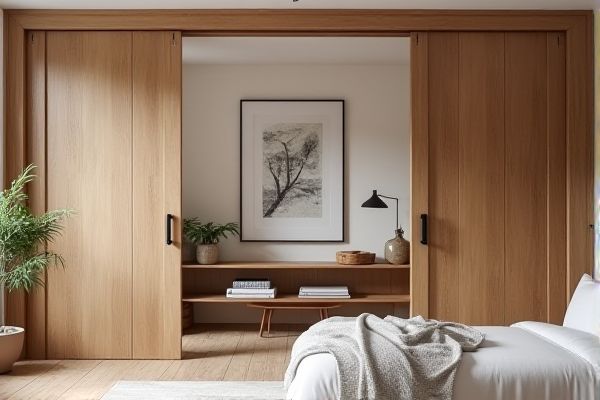
Sliding doors save space by gliding along tracks, making them ideal for small or narrow areas, while swinging doors offer wide accessibility with a classic look but require clearance to open. Discover how to choose the best cabinet door style for your space by reading the full article.
Table of Comparison
| Feature | Sliding Doors (Cabinets) | Swinging Doors (Cabinets) |
|---|---|---|
| Space Efficiency | Highly space-saving; no clearance needed for door swing | Requires clearance space to open outward |
| Installation Complexity | Moderate; requires track installation and alignment | Simple; standard hinges and mounting |
| Maintenance | Requires periodic track cleaning and rolling mechanism checks | Minimal; hinge lubrication occasionally needed |
| Durability | Sliding tracks and rollers may wear over time | Generally robust, standard hinges last long |
| Accessibility | Partial access (one door at a time) | Full access when door opened |
| Design Versatility | Modern aesthetic; suitable for contemporary designs | Classic look; wide design options |
| Cost | Usually more expensive due to hardware | Typically less expensive and easier to replace |
Introduction to Sliding and Swinging Cabinet Doors
Sliding cabinet doors maximize space efficiency by gliding along tracks, making them ideal for compact areas and modern interiors. Swinging cabinet doors offer traditional accessibility with hinged panels that open outward, providing full access to cabinet contents and a classic aesthetic. Both types cater to different functional needs and design preferences in cabinetry.
Space Efficiency: Sliding vs Swinging Doors
Sliding cabinet doors maximize space efficiency by gliding along tracks without requiring extra clearance, making them ideal for tight or narrow areas. Swinging doors demand clear space to open outward, potentially obstructing pathways or limiting furniture placement in compact rooms. Choosing sliding doors optimizes your storage access while preserving room layout and flow.
Aesthetic Appeal and Design Flexibility
Sliding doors offer a sleek, minimalist aesthetic that enhances modern cabinetry with clean lines and space-saving functionality. Their design flexibility accommodates various materials like glass, wood, or metal, allowing for customized looks in tight spaces. In contrast, swinging doors provide a traditional appearance with greater ease of access and the option for intricate panel designs, but require more clearance for operation.
Installation and Maintenance Requirements
Sliding cabinet doors require precise track installation and occasional track cleaning to ensure smooth operation, making initial setup slightly more complex than swinging doors. Swinging cabinet doors are easier to install with standard hinges and need regular hinge lubrication and alignment adjustments to prevent sagging. Both door types demand periodic checks, but sliding doors often require more attention to track and roller maintenance for optimal performance.
Accessibility and Ease of Use
Sliding doors provide seamless accessibility in tight spaces, allowing you to open cabinets without requiring additional clearance. Swinging doors offer full access with a wide opening, ideal for reaching the entire cabinet interior quickly. Your choice depends on space constraints and how you prioritize convenience in daily use.
Durability and Hardware Longevity
Sliding cabinet doors typically offer enhanced durability due to their simpler track system, which reduces wear and tear on hinge components compared to swinging doors. High-quality sliding door hardware, such as ball-bearing rollers and corrosion-resistant tracks, extends operational lifespan and minimizes maintenance requirements. Conversely, swinging doors rely on hinges that may loosen or rust over time, necessitating periodic adjustment or replacement to maintain smooth function.
Cost Comparison: Sliding vs Swinging
Sliding cabinet doors typically cost more upfront due to specialized track hardware and installation requirements, while swinging doors generally have lower initial expenses. Maintenance and repair costs for sliding doors can be higher because of track cleaning and potential alignment issues, whereas swinging doors often incur fewer upkeep expenses. Your choice depends on balancing these cost factors with space efficiency and design preferences.
Safety Considerations for Different Environments
Sliding doors reduce the risk of injury in tight spaces by eliminating door swing, making them ideal for crowded or narrow environments. In contrast, swinging doors may pose a hazard due to their potential to hit occupants or objects, especially in high-traffic areas or homes with children. Safety hardware such as soft-close mechanisms enhances both door types by preventing abrupt closure and minimizing finger injuries.
Best Applications for Sliding and Swinging Cabinet Doors
Sliding cabinet doors are ideal for tight spaces where swinging doors may obstruct walkways or nearby furniture, making them perfect for small kitchens, closets, and bathrooms. Swinging cabinet doors offer easier access to the entire cabinet interior at once, suited for larger rooms or areas where space is not a constraint, such as open kitchens or utility rooms. Both door types are chosen based on space availability and accessibility needs, with sliding doors enhancing compactness and swinging doors providing full entry.
Conclusion: Choosing the Right Cabinet Door Type
Sliding doors maximize space efficiency by gliding along tracks, ideal for tight areas or modern designs, while swinging doors offer easier full-door access and traditional appeal. Consider room layout, frequency of use, and style preference when selecting between sliding and swinging cabinet doors. Optimal cabinet functionality depends on balancing space constraints and user convenience to meet personal and practical needs.
 homyna.com
homyna.com